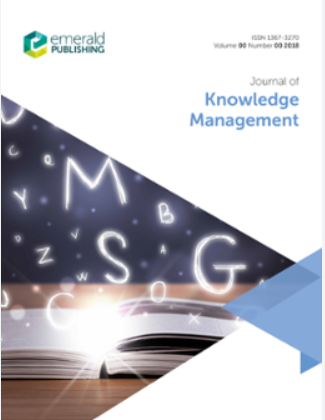Object-control and human-control in the development of sustainable innovation: exploring the interactions among epistemic objects, Guanxi network and knowledge integration of “who knows what”
IF 6.6
2区 管理学
Q1 INFORMATION SCIENCE & LIBRARY SCIENCE
引用次数: 0
Abstract
Purpose This study aims to explore how coworkers leverage epistemic objects and guanxi (a Chinese term defining relationships based on mutual dependence) network to promote knowledge integration of “who knows what” in the development of sustainable innovation. Design/methodology/approach This study used a mixed-methods research approach, including quantitative questionnaires, social network analyses and a qualitative ethnography, all of which were collected from a large enterprise in China. Findings Epistemic objects can promote knowledge integration of “who knows what” among coworkers during their innovation development process. In addition, structural holes in a coworker network will impede knowledge integration of “who knows what,” but guanxi can turn this impeding effect into a facilitating effect. Research limitations/implications First, the focus on the role of epistemic objects in eliciting knowledge generates implications for creating employee identity and coordinating knowledge heterogeneity. Second, by demonstrating how epistemic objects trigger both affective and cognitive trust to promote knowledge integration of “who knows what,” the authors complement existing studies of knowledge management (KM). Third, by presenting how coworkers fill their structural holes in their collaborative innovation, the study reveals the nature of connecting the appropriate resources with the appropriate needs, which generates implications for social capital integration and innovation enhancement. Fourth, by showing how “structural hole controllers” become “structural hole fillers” under different conditions, the authors recognize the different ways in which brokers leverage their structural holes and highlight the unique role of Chinese guanxi culture in triggering a structural hole filling behavior, thereby contributing to the literature of structural hole theory and culture management. Fifth, by creating a full picture of how coworkers strategically leverage their knowledge of “who knows what” in the development of sustainable innovation, the authors identify the influential factor that stimulates innovation, adding to the literature on the interaction between KM and innovation. Sixth, the emphasis on the independent role of epistemic objects produces an implication for the interplay between object-control and human-control in innovation work. Practical implications This study supports organizational leaders to make optimal decisions in their innovation development process by suggesting them to invest in developing an integrated knowledge of “who knows what.” To achieve it, the authors suggest managers make good use of non-human artifacts to gain the identification with the knowledge of not only themselves but also the whole team, and award the “integrator” an honor for filling structural holes that may trigger the creation of more structural hole fillers. Furthermore, the focus on the independent role of epistemic objects as knowledge elicitors and trust triggers in innovation work generates another practical implication for managers to rethink the controlling role of objects and humans in the organization and modify their managerial practices accordingly. Originality/value By exploring how coworkers leverage epistemic objects and guanxi network to promote knowledge integration of “who knows what” in the development of sustainable innovation, this study reveals the role of object-control and human-control in facilitating knowledge practices for stimulating innovation, thereby contributing to the literature of KM and innovation.可持续创新发展中的 "物控 "与 "人控":探索认识对象、关西网络与 "谁知道什么 "的知识整合之间的互动关系
研究目的本研究旨在探讨在可持续创新发展过程中,同事如何利用认识对象和关系网络促进 "谁知道什么"(who knows what)的知识整合。此外,同事网络中的结构性漏洞会阻碍 "谁知道什么 "的知识整合,但 "关系 "可以将这种阻碍效应转化为促进效应。研究局限/启示首先,关注认识对象在激发知识方面的作用会对创建员工身份认同和协调知识异质性产生影响。其次,通过展示认识对象如何触发情感和认知信任以促进 "谁知道什么 "的知识整合,作者补充了现有的知识管理(KM)研究。第三,该研究通过介绍同事如何在协作创新中填补结构性漏洞,揭示了将适当的资源与适当的需求联系起来的本质,从而对社会资本整合和创新提升产生影响。第四,通过展示 "结构洞控制者 "如何在不同条件下成为 "结构洞填补者",作者认识到了经纪人利用结构洞的不同方式,并强调了中国关西文化在引发结构洞填补行为中的独特作用,从而为结构洞理论和文化管理文献做出了贡献。第五,通过全面描绘同事如何战略性地利用 "谁知道什么 "的知识来发展可持续创新,作者发现了激发创新的影响因素,从而为知识管理与创新之间的互动关系的文献做出了贡献。第六,对认识对象独立作用的强调,对创新工作中对象控制与人的控制之间的相互作用产生了影响。 实践意义本研究建议组织领导者投资开发 "谁知道什么 "的综合知识,从而支持他们在创新发展过程中做出最佳决策。为实现这一目标,作者建议管理者善用非人类人工制品,以获得对不仅是自己而且是整个团队的知识的认同,并授予 "整合者 "填补结构性漏洞的荣誉,这可能会引发更多结构性漏洞填补者的产生。此外,对认识对象在创新工作中作为知识激发者和信任触发器的独立作用的关注,为管理者重新思考物和人在组织中的控制作用并相应修改其管理实践提供了另一种实践启示。 原创性/价值通过探讨同事如何利用认识对象和关系网络来促进可持续创新发展中 "谁知道什么 "的知识整合,本研究揭示了物控制和人控制在促进激发创新的知识实践中的作用,从而为知识管理和创新文献做出了贡献。
本文章由计算机程序翻译,如有差异,请以英文原文为准。
求助全文
约1分钟内获得全文
求助全文
来源期刊

Journal of Knowledge Management
Multiple-
CiteScore
13.70
自引率
15.70%
发文量
99
期刊介绍:
Knowledge Management covers all the key issues in its field including:
■Developing an appropriate culture and communication strategy ■Integrating learning and knowledge infrastructure
■Knowledge management and the learning organization
■Information organization and retrieval technologies for improving the quality of knowledge
■Linking knowledge management to performance initiatives ■Retaining knowledge - human and intellectual capital
■Using information technology to develop knowledge management ■Knowledge management and innovation
■Measuring the value of knowledge already within an organization ■What lies beyond knowledge management?
 求助内容:
求助内容: 应助结果提醒方式:
应助结果提醒方式:


